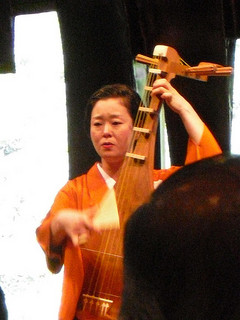Biwa

- Japanese: 琵琶 (biwa)
The biwa is a Japanese stringed lute. Most closely associated with the tradition of the recitation of the Tale of the Heike, the biwa is also played in gagaku and in a number of other traditional and folk contexts.
The biwa is closely derived from the Chinese pípa, which was first introduced to Japan in the 7th century. At least one ancient pípa from that time is stored in the Shôsôin Imperial Repository. Unlike the pípa, however, which is held vertically and plucked with the fingers, the Japanese biwa is typically held horizontally, and played with a large plectrum. Outside of gagaku, the biwa is typically played with the left hand depressing the strings in between frets to produce a wider range of notes.
Styles of biwa instruments include the Heike biwa, Satsuma biwa, and moso biwa.
References
- Gallery labels, Metropolitan Museum of Art, Musical Instruments gallery.